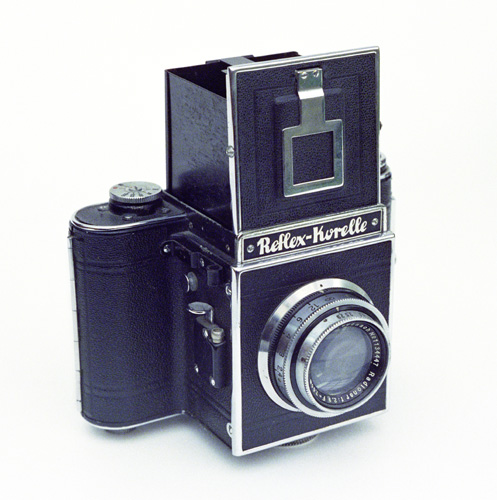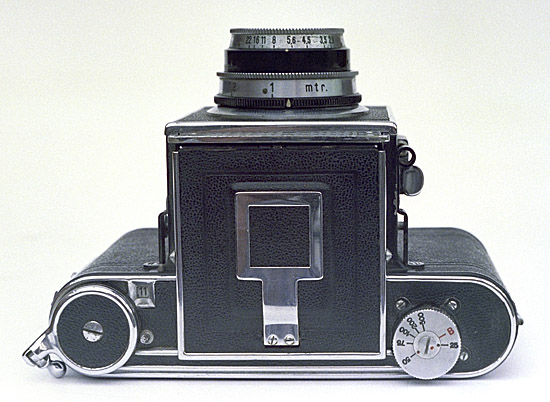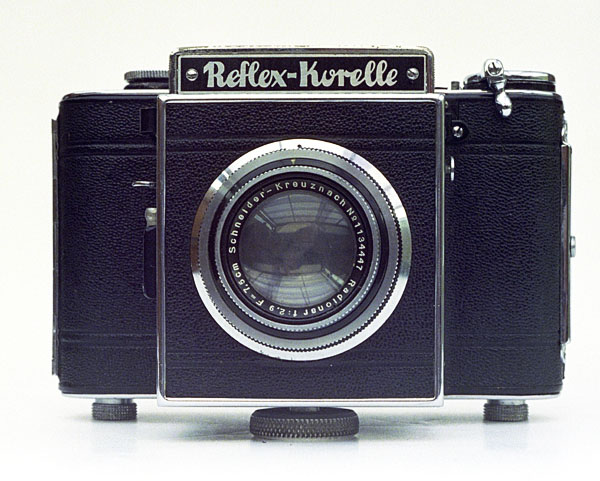by TRA
The History of the Pentacon Six
The Reflex Korelle
Date: 1935

[C151_8.jpg] The first model of the Reflex Korelle |
In the same year as the Noviflex I, 1935,
the Dresden camera manufacturer Franz Kochmann showed the Reflex Korelle
6 × 6 at the Leipziger Messe (Trade Fair) (Hummel pp 88-89).
This beautiful and reliable camera entered production and was gradually
improved in various models over the subsequent years until just before
the beginning of the war. Some of the principal lens manufacturers
made lenses for it, and it was commercially successful. Focal lengths
of available lenses ranged from 75mm to 500mm (in the style of the time,
frequently referred to in centimetres: 7.5 cm – 50 cm).
Features of the Reflex Korelle It had a cloth focal plane shutter with the speeds from 1/10 to 1/1000, although later models had the speeds B 1/25 1/50 1/75 1/100 1/200 and 1/500. No flash synchronisation was provided on the original Reflex-Korelle, although some users had this added subsequently. The body accepted interchangeable lenses via a 40.5mm diameter × 0.75 screw thread mount. A manual Schneider Kreuznach Radionar lens marked f/2.9 7.5cm was supplied as standard. There were also f/3.5 and f/2.8 Xenars from Schneider
and a 7.5cm Tessar from Carl Zeiss, as well as f/2.9 & f/3.5 7.5cm
Victars.
|
| There was no viewfinder prism and of course no light
metering facility on the camera. Viewing was through a non-removable
waist-level finder made with four fold-up metal sides, and there was a
fold-up magnifier. The reflex image was as bright as one can get
with a plain glass, but in most Reflex-Korelles that I have seen, the brightness
has been poor by modern standards, although this has been partly due to
deterioration of the silvering on the mirror. Closing the waist-level
finder gave access to a direct-vision finder useful when photographing
sports or other moving objects. This looked remarkably similar to
the Noviflex direct-vision finder, in spite of a more sophisticated design.
As with the Noviflex, the mirror was gradually raised by pressure on a lever to the right of the throat (viewed from behind). Letting go of this lever allowed the mirror to drop back down; pressing it to the end of its travel fired the shutter, after which the mirror came back down as the lever was released. The film was advanced by a lever on the top plate operated by the left hand. Apart from on the cheapest model (referred to by some as “Model B” or “Model IB”), this lever also cocked the shutter, but there was no frame counter on the early models; the traditional red window on the camera back enabled the user to check the number of pictures taken from the numbers printed on the backing paper. |

[C151_15.jpg] The single shutter speed dial gives speeds from 1/25 to 1/500 plus B |

[C151_20.jpg] |
On the base-plate were two knobs which were pulled out
and twisted when inserting or removing film spools – not in itself a new
development, but one also adopted for the Pentacon Six, with slightly larger
diameter knobs.
The Reflex-Korelle with the Schneider-Kreuznach Radionar lens weighted fractionally less than the Noviflex, at 1lb 12½oz (c. 805 grs), and its dimensions were 5 23/32" × 3 5/8" × 3 13/16" (145 × 92 × 97mm). |
A note on wide-angle lenses
Note that no wide angle lenses were available for the
6 × 6 SLR format before the 1950s. In fact, one of the first
wide angle lenses for a Medium Format SLR was the 65mm Flektogon from Carl
Zeiss, Jena. Two prototypes of this lens were produced in the Meister-Korelle
mount in March 1952, and a further two prototypes, in another mount, in
May 1953 (Thiele, p 190). Carl Zeiss in Oberkochen, West Germany,
produced a 60mm f/5.6 Distagon wide-angle lens for the Hasselblad 1600F
and 1000F, with first deliveries of the lens taking place in early 1954
(Nordin, p 40) The first 65mm Flektogons in the Praktisix mount were
produced in September 1956. This lens was two lens stops “faster”
than the Oberkochen f/5.6 lens, having an amazing maximum aperture of f/2.8,
although this was at the price of an extremely large front element that
resulted in a heavy lens.
To go to the Bibliography, click here.
To go on to the next section, click below.
08 The Reflex Korelle II
To go to the beginning of the history section, click here.
To go to introduction to the cameras, click here.
To choose other options, click below.
Home
© TRA August 2010, revised July 2012